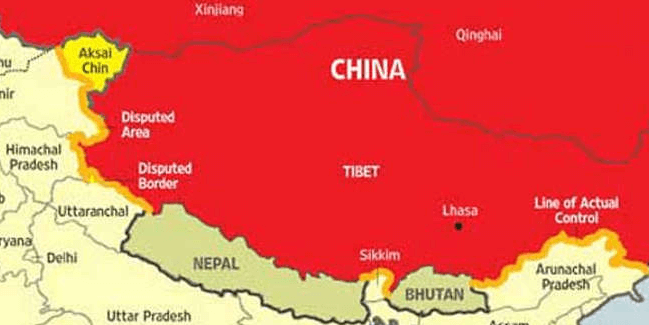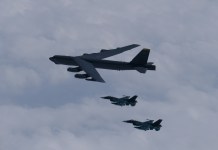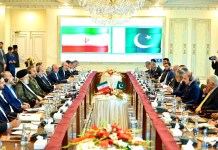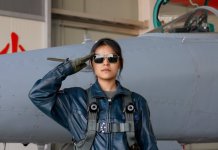With India gearing up to welcome the arrival of the second batch of French Dassault Rafales this month, the country’s northern Ambala Air Force Base will shelter nine of the 36 formidable aerial beasts, ready to soar across the 477-kilometre distance to Ladakh at the drop of a hat.
French Jets, Russian Missiles & Dooms Day For The Mightiest Of The Tanks – Watch The Annihilation
However, while the fighters will indeed provide the country with incredible aerial prowess against China in a battle over the region, India has something else within its locker which may finally land a fatal blow to President Xi Jinping’s expansionist agenda—a Russian monster waiting to be unleashed.
Indian Defence Minister Rajnath Singh formally opened 44 bridges built by the army’s Border Roads Organisation (BRO) delivering what New Delhi called a record-breaking performance. The 44 are among the 102 bridges that are being built by the BRO designed to withstand movement of one of India’s heaviest battle tanks – the T-90s.
Originating out of the need for replacing the T-64, T-72 and T-80 series of main battle tanks during the Soviet era, the T-90 third-generation battle tank was built in 1992 and entered Russian service a year later.
A modern variation of the T-72B, the T-90 incorporates many features found on the T-80U and has been mainly in service of the Russian Ground Forces and its Naval Infantry.
Following the acquisition of 320 Ukrainian T-84 tanks by Pakistan, India showcased an interest to procure the T-90s following which India ended up getting the first batch of 42 tanks in 2001, with an additional delivery of 82 tanks a year later.
According to defence writer, Caleb Larson writing for the National Interest – “Back in the early 2000s, India bought several hundred T-90 tanks from Russia and has since grown a formidable collection of actually quite capable armour.
The Russian T-90s, while quite capable on their own, (actually just plain tough) were a strategic decision for India. India fields a fairly extensive fleet of domestically build T-72s. These T-72s shares a number of components in common with the T-90 platform (possibly as high as 60%), which would, in theory, simplify logistics and repairs.”
India now operates the modernised variant of those tanks, called the T-90M Bhishma— named after a great legend named Bhishma Pitamaha, from the Indian epic Mahabharata.
Owing to the skyrocketing tensions in Eastern Ladakh between the militaries of India and China, both of which have entered a fifth-month standoff, New Delhi has deployed large numbers of the T-90 Bhishma Tanks along with T-72 tanks and BMP-2 infantry combat vehicles in key areas of the region.
“With the Chinese People’s Liberation Army (PLA) deploying close to 50,000 troops in Aksai Chin, the Indian Army for the first time has deployed a squadron (12) T-90 missile-firing tanks, armoured personnel carriers (APCs) and a full troop brigade (4,000 men) at Daulat Beg Oldi to prevent any Chinese aggression from the Shaksgam-Karakoram pass axis.” according to the Hindustan Times.
#WATCH Indian Army deploys T-90 & T-72 tanks along with BMP-2 Infantry Combat Vehicles that can operate at temperatures up to minus 40 degree Celsius, near Line of Actual Control in Chumar-Demchok area in Eastern Ladakh.
Note: All visuals cleared by competent authority on ground pic.twitter.com/RiRBv4sMud
— ANI (@ANI) September 27, 2020
Indian Army’s T-90 Bhishma tank carrying out static manoeuvres at tank-range near LAC in Chumar-Demchok, Eastern Ladakh. India has deployed tanks at highest possible altitude in world to tackle threat on its northern borders.
Note:Visuals cleared by competent authority on ground pic.twitter.com/nb2B0w6z9d
— ANI (@ANI) September 27, 2020
According to news sources, the T-90s have been set to carry out operations in the Depsang Plains in the sub-sector north (SSN) where the Chinese troops have prevented Indian troops from patrolling in patrol points (PPs) 10-13.
The high-altitude 802.9 kilometer region which is located at the northwest portion of the disputed Aksai Chin region, has already seen two major standoffs between Indian and Chinese forces back in 2013 and 2015.
Amid the growing tensions between #India and #China, the #Indianarmy has already deployed the T-90 Bhishma Tank in #Ladakh, which is considered to be the most dependable tank in the worldhttps://t.co/WeJFr4Qq4t
— FinancialXpress (@FinancialXpress) July 21, 2020
The Depsang plains despite their acute climatic conditions are flat and therefore are very suitable for the T-90 tanks, with the plains becoming a critical point where Indian tanks could threaten the Aksai Chin area at the eastern portion of the Kashmir region.
Similar to India, China has deployed the 30-ton Type 15 light tanks, which can fire shells and anti-tank guided missiles. The tanks which are claimed by the Chinese to be 1,000-horsepower diesel are suitable for the terrain due to being lightweight.

Michael Peck, writing for Forbes, says – “India has customized its variant, the T-90S Bhishma, with non-Russian gear such as a French thermal imaging system. The Type 15’s lightweight may enable it to use roads and bridges that the T-90 can’t. One the other hand, India’s 1,000 T-90s have superior firepower and armour protection.”
Moreover, the tank has been specially designed to operate in the cold and harsh conditions of Ladakh, Sikkim and Arunachal Pradesh regions of the country.
Despite the hostile conditions of the region, with temperatures plummeting to minus 35 degrees and high-speed freezing winds, the T-90 tanks can remain operational at even minus 40 degrees Celsius due to the use of special fuels which do not freeze in sub-zero temperatures.
“But even in the mountains, tanks still offer something unique: a big, heavily armoured, mobile cannon that can deliver far more firepower than what a foot soldier can carry on his back. Modern vehicles like the T-90 also have thermal sights and other advanced sensors to spot targets at night and in fog,”
While there will be no armoured blitzkriegs in the Himalayas, tanks can provide invaluable fire support to the infantry. On the other hand, in restricted terrain, tanks will need the infantry to protect them from man-portable anti-tank rockets.” said Peck.
However, the movement of such 45-ton tanks in a mountainous region like Ladakh with its poor roads and bridges has been a huge challenge.
In what will be a huge boost to Indian armed forces, Indian Defence Minister Rajnath Singh last week formally opened a total of 44 bridges among the 102 bridges currently being built under Indian Army’s Border Roads Organisation (BRO).
The bridges have been specially designed to withstand the movement of India’s heaviest battle tanks among which is the county’s heaviest battle tank, Arjun weighing 60 tonnes, with the T-90s coming after that.
“These bridges of various spans, constructed by BRO, range from 30 metres to 484 metres are of strategic importance and have been designed to facilitate the movement of heavy civil and military traffic in border areas,” said BRO Chief Lieutenant General Harpal Singh





